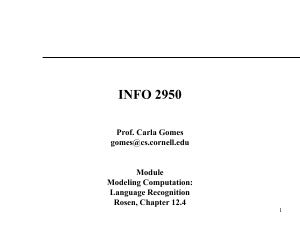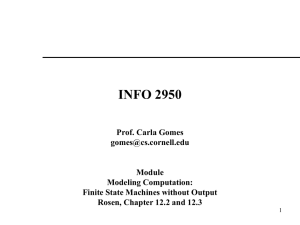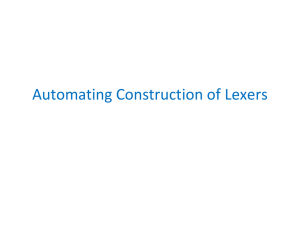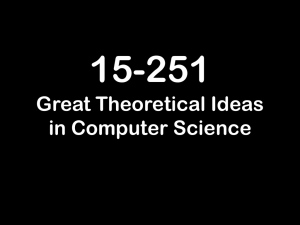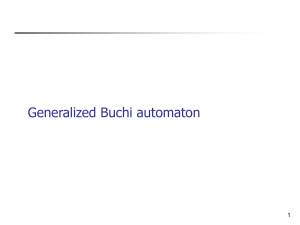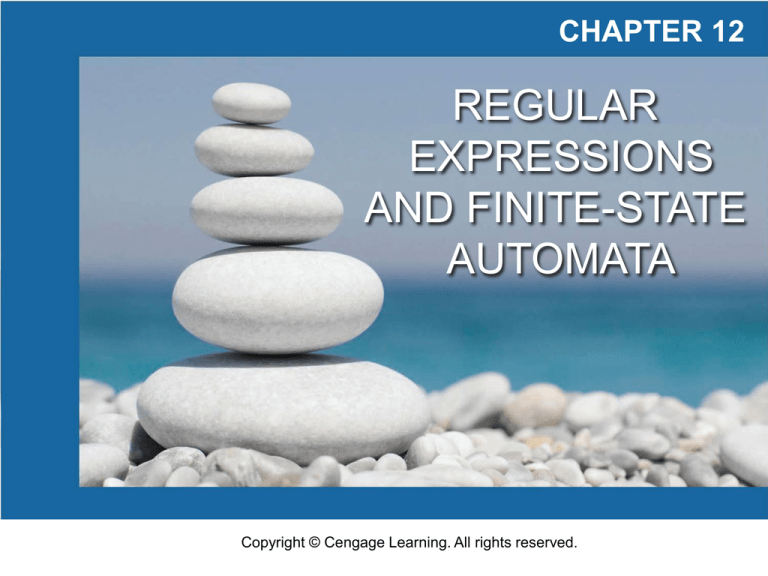
CHAPTER 12
REGULAR
EXPRESSIONS
AND FINITE-STATE
AUTOMATA
Copyright © Cengage Learning. All rights reserved.
SECTION 12.2
Finite-State Automata
Copyright © Cengage Learning. All rights reserved.
Finite-State Automata
Gates can be combined into circuits in a variety of ways. If
the rules shown below are obeyed, the result is a
combinational circuit, one whose output at any time is
determined entirely by its input at that time without regard
to previous inputs.
Rules for a Combinational circuit
• Never combine two input wires.
• A single input wire can be split partway and used as input
for two separate gates.
• An output wire can be used as input.
• No output of a gate can eventually feed back into that
gate.
3
Finite-State Automata
Combinational Circuit is characterized by the fact that its
output is completely determined by its input/output table,
or, in other words, by a Boolean function.
Its output does not depend in any way on the history of
previous inputs to the circuit. For this reason, a
combinational circuit is said to have no memory.
Combinational circuits are very important in computer
design, but they are not the only type of circuits used.
Equally important are sequential circuits.
4
Finite-State Automata
For sequential circuits one cannot predict the output
corresponding to a particular input unless one also knows
something about the prior history of the circuit, or, more
technically, unless one knows the state the circuit was in
before receiving the input.
The behavior of a sequential circuit is a function not only of
the input to the circuit but also of the state the circuit is in
when the input is received. A computer memory circuit is a
type of sequential circuit.
A finite-state automaton (aw-TAHM-uh-tahn) is an
idealized machine that embodies the essential idea of a
sequential circuit.
5
Finite-State Automata
Each piece of input to a finite-state automaton leads to a
change in the state of the automaton, which in turn affects
how subsequent input is processed.
Imagine, for example, the act of dialing a telephone
number. Dialing 1–800 puts the telephone circuit in a state
of readiness to receive the final seven digits of a toll-free
call, whereas dialing 328 leads to a state of expectation for
the four digits of a local call. Vending machines operate
similarly.
Just knowing that you put a quarter into a vending machine
is not enough for you to be able to predict what the
behavior of the machine will be.
6
Finite-State Automata
You also have to know the state the machine was in when
the quarter was inserted. If 75 had already been deposited,
you might get a beverage or some candy, but if the quarter
was the first coin deposited, you would probably get nothing
at all.
7
Example 1 – A Simple Vending Machine
A simple vending machine dispenses bottles of juice that
cost $1 each.
The machine accepts quarters and half-dollars only and
does not give change.
As soon as the amount deposited equals or exceeds $1 the
machine releases a bottle of juice.
The next coin deposited starts the process over again.
8
Example 1 – A Simple Vending Machine cont’d
The operation of the machine is represented by the
diagram of Figure 12.2.1.
A Simple Vending Machine
Figure 12.2.1
9
Example 1 – A Simple Vending Machine cont’d
Each circle represents a state of the machine: the state in
which 0 has been deposited, 25 , 50 , 75 , and $1 or
more.
The unlabeled arrow pointing to “0 deposited” indicates
that this is the initial state of the machine.
The double circle around “$1 or more deposited” indicates
that a bottle of juice is released when the machine has
reached this state.
(It is called an accepting state of the machine because
when the machine is in this state, it has accepted the input
sequence of coins as payment for juice.)
10
Example 1 – A Simple Vending Machine cont’d
The arrows that link the states indicate what happens when
a particular input is made to the machine in each of its
various states.
For instance, the arrow labeled “quarter” that goes from “0
deposited” to “25 deposited” indicates that when the
machine is in the state “0 deposited” and a quarter is
inserted, the machine goes to the state “25 deposited.”
11
Example 1 – A Simple Vending Machine cont’d
The arrow labeled “half-dollar” that goes from “75
deposited” to “$1 or more deposited” indicates that when
the machine is in the state “75 deposited” and a half-dollar
is inserted, the machine goes to the state “$1 or more
deposited” and juice is dispensed.
(In this case the purchaser would pay $1.25 for the juice
because the machine does not return change.)
12
Example 1 – A Simple Vending Machine cont’d
The arrow labeled “quarter” that goes from “$1 or more
deposited” to “25 deposited” indicates that when the
machine is in the state “$1 or more deposited” and a quater
is inserted, the machine goes back to the state “25
deposited.”
(This corresponds to the fact that after the machine has
dispensed a bottle of juice, it starts operation all over
again.)
13
Example 1 – A Simple Vending Machine cont’d
Equivalently, the operation of the vending machine can be
represented by a next-state table as shown in Table 12.2.1.
Next-State Table
Table 12.2.1
14
Example 1 – A Simple Vending Machine cont’d
The arrow pointing to “0 deposited” in the table indicates
that the machine begins operation in this state.
The double circle next to “$1 or more deposited” indicates
that a bottle of juice is released when the machine has
reached this state.
Entries in the body of the table are interpreted in the
obvious way.
15
Example 1 – A Simple Vending Machine cont’d
For instance, the entry in the third row of the column
labeled Half-Dollar shows that when the machine is in state
“50 deposited” and a half-dollar is deposited, it goes to
state “$1 or more deposited.” Note that Table 12.2.1
conveys exactly the same information as the diagram of
Figure 12.2.1.
Next-State Table
Table 12.2.1
16
Example 1 – A Simple Vending Machine cont’d
A Simple Vending Machine
Figure 12.2.1
If the diagram is given, the table can be constructed; and if
the table is given, the diagram can be drawn.
17
Definition of a Finite-State
Automaton
18
Definition of a Finite-State Automaton
A general finite-state automaton is completely described by
giving a set of states, together with an indication about
which is the initial state and which are the accepting states
(when something special happens), a list of all input
elements, and specification for a next-state function that
defines which state is produced by each input in each
state.
19
Definition of a Finite-State Automaton
This is formalized in the following definition:
20
Definition of a Finite-State Automaton
The operation of a finite-state automaton is commonly
described by a diagram called a (state-)transition
diagram, similar to that of Figure 12.2.1.
A Simple Vending Machine
Figure 12.2.1
21
Definition of a Finite-State Automaton
It is called a transition diagram because it shows the
transitions the machine makes from one state to another in
response to various inputs.
In a transition diagram, states are represented by circles
and accepting states by double circles.
There is one arrow that points to the initial state and other
arrows that are labeled with input symbols and point from
each state to other states to indicate the action of the
next-state function.
22
Definition of a Finite-State Automaton
Specifically, an arrow from state s to state t labeled m
means that N(s, m) = t.
The next-state table for an automaton shows the values of
the next-state function N for all possible states s and input
symbols i.
In the annotated next-state table, the initial state is
indicated by an arrow and the accepting states are marked
by double circles.
23
Example 2 – A Finite-State Automaton Given by a Transition Diagram
Consider the finite-state automaton A defined by the
transition diagram shown in Figure 12.2.2.
Figure 12.2.2
a. What are the states of A?
b. What are the input symbols of A?
c. What is the initial state of A?
24
Example 2 – A Finite-State Automaton Given by a Transition Diagram
cont’d
d. What are the accepting states of A?
e. Determine N(s1, 1).
f. Construct the annotated next-state table for A.
Solution:
a. The states of A are s0, s1, and s2 [since these are the
labels of the circles].
b. The input symbols of A are 0 and 1 [since these are the
labels of the arrows].
25
Example 2 – Solution
cont’d
c. The initial state of A is s0 [since the unlabeled arrow
points to s0].
d. The only accepting state of A is s2 [since this is the only
state marked by a double circle].
e. N(s1, 1) = s2 [since there is an arrow from s1 to s2 labeled
1].
f.
26
The Language Accepted by
an Automaton
27
The Language Accepted by an Automaton
Now suppose a string of input symbols is fed into a
finite-state automaton in sequence.
At the end of the process, after each successive input
symbol has changed the state of the automaton, the
automaton ends up in a certain state, which may be either
an accepting state or a nonaccepting state.
In this way, the action of a finite-state automaton separates
the set of all strings of input symbols into two
subsets: those that send the automaton to an accepting
state and those that do not.
28
The Language Accepted by an Automaton
Those strings that send the automaton to an accepting
state are said to be accepted by the automaton.
29
Example 4 – Finding the Language Accepted by an Automaton
Consider the finite-state automaton A shown below.
a. To what states does A go if the symbols of the following
strings are input to A in sequence, starting from the
initial state?
(i) 01 (ii) 0011 (iii) 0101100 (iv) 10101
b. Which of the strings in part (a) send A to an accepting
state?
30
Example 4 – Finding the Language Accepted by an Automaton
cont’d
c. What is the language accepted by A?
d. Is there a regular expression that defines the same
language?
Solution:
a. (i) s2 (ii) s0
(iii) s1
(iv) s2
b. The strings 01 and 10101 send A to an accepting
state.
c. Observe that if w is any string that ends in 01, then w
is accepted by A.
31
Example 4 – Solution
cont’d
For if w is any string of length n 2, then after the first
n – 2 symbols of w have been input, A is in one of its
three states: s0, s1, or s2.
But from any of these three states, input of the symbols
01 in sequence sends A first to s1 and then to the
accepting state s2. Hence any string that ends in 01 is
accepted by A.
Also note that the only strings accepted by A are those
that end in 01. (That is, no other strings besides those
ending in 01 are accepted by A.)
32
Example 4 – Solution
cont’d
The reason for this is that the only accepting state of A is
s2, and the only arrow pointing to s2 comes from s1 and is
labeled 1.
Thus in order for an input string w of length n to send A
to an accepting state, the last symbol of w must be a 1
and the first n – 1 symbols of w must send A to state s1.
Now three arrows point to s1, one from each of the three
states of A, and all are labeled 0. Thus the last of the first
n – 1 symbols of w must be 0, or, in other words, the
next-to-the-last symbol of w must be 0.
33
Example 4 – Solution
cont’d
Hence the last two symbols of w must be 01, and thus
L(A) = the set of all strings of 0’s and 1’s that end in 01.
d. Yes. One regular expression that defines L(A) is
(0 | 1)∗01.
34
The Language Accepted by an Automaton
A finite-state automaton with multiple accepting states can
have output devices attached to each one so that the
automaton can classify input strings into a variety of
different categories, one for each accepting state.
This is how finite-state automata are used in the lexical
scanner component of a computer compiler to group the
symbols from a stream of input characters into identifiers,
keywords, and so forth.
35
The Eventual-State Function
36
The Eventual-State Function
Now suppose a finite-state automaton is in one of its states
(not necessarily the initial state) and a string of input
symbols is fed into it in sequence.
To what state will the automaton eventually go? The
function that gives the answer to this question for every
possible combination of input strings and states of the
automaton is called the eventual-state function.
37
The Eventual-State Function
38
Example 5 – Computing Values of the Eventual-State Function
Consider again the finite-state automaton of Example 2
shown below for convenience. Find N∗(s1, 10110).
Solution:
By definition of the eventual-state function,
39
Example 5 – Solution
cont’d
By referring to the transition diagram for A, you can see
that starting from s1, when a 1 is input, A goes to s2; then
when a 0 is input, A goes back to s1; after that, when a 1 is
input, A goes to s2; from there, when a 1 is input, A goes to
s0; and finally, when a 0 is input, A goes back to s1.
This sequence of state transitions can be written as follows:
Thus, after all the symbols of 10110 have been input in
sequence, the eventual state of A is s1, so
40
The Eventual-State Function
The definitions of string and language accepted by an
automaton can be restated symbolically using the
eventual-state function.
Suppose A is a finite-state automaton with set of input
symbols I and next-state function N, and suppose that I∗ is
the set of all strings over I and that w is a string in I∗.
41
Designing a Finite-State
Automaton
42
Example 6 – A Finite-State Automaton That Accepts the Set of Strings of 0’s
and 1’s for Which the Number of 1’s Is Divisible by 3
a. Design a finite-state automaton A that accepts the set of
all strings of 0’s and 1’s such that the number of 1’s in
the string is divisible by 3.
b. Is there a regular expression that defines this set?
Solution:
a. Let s0 be the initial state of A, s1 its state after one 1 has
been input, and s2 its state after two 1’s have been input.
Note that s0 is the state of A after zero 1’s have been
input, and since zero is divisible by 3 (0 = 0·3), s0 must
be an accepting state.
43
Example 6 – Solution
cont’d
The states s0, s1, and s2 must be different from one
another because from state s0 three 1’s are needed to
reach a new total divisible by 3, whereas from state s1
two additional 1’s are necessary, and from state s2 just
one more 1 is required.
Now the state of A after three 1’s have been input can also
be taken to be s0 because after three 1’s have been input,
three more are needed to reach a new total divisible by 3.
More generally, if 3k 1’s have been input to A, where k is
any non-negative integer, then three more are needed for
the total again to be divisible by 3(since 3k + 3 = 3(k + 1)).
44
Example 6 – Solution
cont’d
Thus the state in which 3k 1’s have been input, for any
nonnegative integer k, can be taken to be the initial state
s0.
By similar reasoning, the states in which (3k + 1) 1’s and
(3k + 2) 1’s have been input, where k is a nonnegative
integer, can be taken to be s1 and s2, respectively.
Now every nonnegative integer can be written in one of the
three forms 3k, 3k + 1, or 3k + 2, so the three states
s0, s1, and s2 are all that is needed to create A.
45
Example 6 – Solution
cont’d
Thus the states of A can be drawn and labeled as shown
below.
Next consider the possible inputs to A in each of its states.
No matter what state A is in, if a 0 is input the total number
of 1’s in the input string remains unchanged.
Thus there is a loop at each state labeled 0.
46
Example 6 – Solution
cont’d
Now suppose a 1 is input to A when it is in state s0. Then A
goes to state s1 (since the total number of 1’s in the input
string has changed from 3k to 3k + 1).
Similarly, if a 1 is input to A when it is in state s1, then A
goes to state s2 (since the total number of 1’s in the input
string has changed from 3k + 1 to 3k + 2).
Finally, if a 1 is input to A when it is in state s2, then it goes
to state s0 (since the total number of 1’s in the input string
becomes (3k + 2) + 1 = 3k + 3 = 3(k + 1), which is a
multiple of 3.)
47
Example 6 – Solution
cont’d
It follows that the transition diagram for A has the
appearance shown below.
b. A regular expression that defines the given set is
0∗ | (0∗10∗10∗10∗)∗.
48
Simulating a Finite-State
Automaton Using Software
49
Simulating a Finite-State Automaton Using Software
Suppose items have been coded with strings of 0’s and 1’s.
A program is to be written to govern the processing of
items coded with strings that end 011; items coded any
other way are to be ignored. This situation can be modeled
by the finite-state automaton shown in Figure 12.2.5.
Figure 12.2.5
50
Simulating a Finite-State Automaton Using Software
The symbols of the code for the item are fed into this
automaton in sequence, and every string of symbols in a
given code sends the automaton to one of the four states
s0, s1, s2, or s3.
If state s3 is reached, the item is processed; if not, the item
is ignored.
51
Simulating a Finite-State Automaton Using Software
The action of this finite-state automaton can be simulated
by a computer algorithm as given in Algorithm 12.2.1.
Algorithm 12.2.1 A Finite-State Automaton
[This algorithm simulates the action of the finite-state
automaton of Figure 12.2.5 by mimicking the functioning of
the transition diagram. The states are denoted 0, 1, 2, and
3.]
Input: string [a string of 0’s and 1’s plus an end marker e]
52
Simulating a Finite-State Automaton Using Software
Algorithm Body:
53
Simulating a Finite-State Automaton Using Software
cont’d
54
Simulating a Finite-State Automaton Using Software
[After execution of the while loop, the value of state is 3 if,
and only if, the input string ends in 011e.]
Output: state
55
Simulating a Finite-State Automaton Using Software
An alternative way to program this automaton is to enter
the values of the next-state function directly as a
two-dimensional array. This is done in Algorithm 12.2.2.
56
Simulating a Finite-State Automaton Using Software
Algorithm 12.2.2 A Finite-State Automaton
[This algorithm simulates the action of the finite-state
automaton of Figure 12.2.5 by repeated application of the
next-state function. The states are denoted 0, 1, 2, and 3.]
Input: string [a string of 0’s and 1’s plus an end marker e]
Figure 12.2.5
57
Simulating a Finite-State Automaton Using Software
Algorithm Body:
N(0, 0) := 1, N(0, 1) := 0, N(1, 0) := 1, N(1, 1) := 2,
N(2, 0) := 1, N(2, 1) := 3, N(3, 0) := 1, N(3, 1) := 0
58
Simulating a Finite-State Automaton Using Software
[After execution of the while loop, the value of state is 3
if, and only if, the input string ends in 011e.]
Output: state
59
Finite-State Automata and
Regular Expressions
60
Finite-State Automata and Regular Expressions
Each time we have considered a language accepted by a
finite-state automaton, we found a regular expression that
defined the same language.
Stephen Kleene showed that our ability to do this is not
sheer coincidence.
He proved that any language accepted by a finite-state
automaton can be defined by a regular expression and
that, conversely, any language defined by a regular
expression is accepted by a finite-state automaton.
61
Finite-State Automata and Regular Expressions
Thus for the many applications of regular expressions, it is
theoretically possible to find a corresponding finite-state
automaton.
In practice, it is often of interest to retain only pieces of the
patterns sought.
For instance, to obtain a reference in an HTML document,
one would specify a regular expression defining the full
HTML tag, <a href= “the desired URL”>, but one would be
interested in retrieving only the string between the
quotation marks.
62
Finite-State Automata and Regular Expressions
Because of these kinds of considerations, actual
implementations of finite-state automata include
additional features.
We break the statement of Kleene’s theorem into two parts.
63
Regular Languages
64
Regular Languages
According to Kleene’s theorem, the set of languages
defined by regular expressions is identical to the set of
languages accepted by finite-state automata. Any such
language is called a regular language.
The brief allusions we made earlier to context-free
languages and Chomsky’s classification of languages
suggest that not every language is regular. We will prove
this by giving an example of a nonregular language.
65
Regular Languages
To construct the example, note that because a finite-state
automaton can assume only a finite number of states and
because there are infinitely many input sequences, by the
pigeonhole principle there must be at least one state to
which the automaton returns over and over again.
This is the essential feature of an automaton that makes it
possible to find a nonregular language.
66
Example 8 – Showing That a Language is Not Regular
Let the language L consist of all strings of the form akbk,
where k is a positive integer. Symbolically, L is the
language over the alphabet = {a, b} defined by
Use the pigeonhole principle to show that L is not regular.
In other words, show that there is no finite-state automaton
that accepts L.
67
Example 8 – Solution
[Use a proof by contradiction.] Suppose not. That is,
suppose there is a finite-state automaton A that accepts L.
[A contradiction will be derived.] Since A has only a finite
number of states, these states can be denoted
s1, s2, s3, . . . , sn, where n is a positive integer.
Consider all input strings that consist entirely of a’s: a, a2,
a3, a4, . . . . Now there are infinitely many such strings and
only finitely many states.
Thus, by the pigeonhole principle, there must be a state sm
and two input strings ap and aq with p ≠ q such that when
either ap or aq is input to A, A goes to state sm.
68
Example 8 – Solution
cont’d
See Figure 12.2.6. [The pigeons are the strings of a’s, the
pigeonholes are the states, and the correspondence
associates each string with the state to which A goes when
the string is input.]
Figure 12.2.6
69
Example 8 – Solution
cont’d
Now, by supposition, A accepts L. Hence A accepts the
string
apbp.
This means that after p a’s have been input, at which point
A is in state sm, inputting p additional b’s sends A into an
accepting state, say sa. But that implies that
aqbp
also sends A to the accepting state sa, and so aqbp is
accepted by A.
70
Example 8 – Solution
cont’d
The reason is that after q a’s have been input, A is also in
state sm, and from that point, inputting p additional b’s
sends A to state sa, which is an accepting state.
Pictorially, if p < q, then
71
Example 8 – Solution
cont’d
Now, by supposition, L is the language accepted by A.
Thus since s is accepted by A, s ∈ L. But by definition of L,
L consists only of strings with equal numbers of a’s and b’s.
So since p q, s L.
Hence s ∈ L and s L, which is a contradiction.
It follows that the supposition is false, and so there is no
finite-state automaton that accepts L.
72

